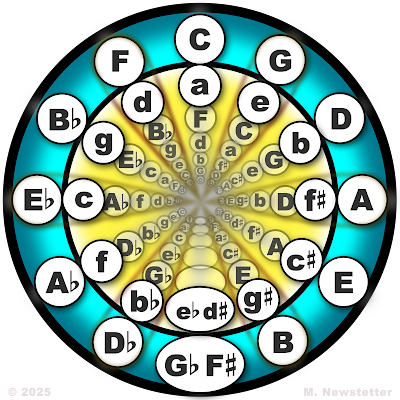Circle of 5ths / 4ths showing all the notes of each key as radial spokes:
Monday, June 23, 2025
The Circle
Notes of each spoke are arranged in descending 3rds starting from the major tonic inward toward the center.
The circle organizes all the diatonic keys based on perfect 5th (clockwise) and perfect 4th (counter-clockwise) intervals. The tonics of the major keys (Ionian Mode) form the outer ring, accompanied by the relative minor tonics (Aeolian Mode) placed one level in toward the center.
We can extend the logic further by adding all the notes of each key in descending 3rds, just as the minor tonic is a 3rd below the major. So, starting from C at the top of the circle, we read the notes C, A, F , D, B, G, E ... essentially a descending arpeggio.
The upper and lower case letters in the diagram represent the major and minor qualities of each 3rd interval for which that note is the (root) ... and can also be treated as the finals of their respective modes: Ionian, Lydian and Mixolydian have major 3rds, so they are upper case. Dorian, Phrygian, Aeolian and Locrian have minor 3rds, so they are lower case.
From the outside in, the modes are: Ionian, Aeolian, Lydian, Dorian, Locrian, Mixolydian and Phrygian.
Numerically, they are I, vi, IV, ii, viiº, V, and iii.
The "Circle of Fifths" is something to ponder. A schematic for the diatonic system which reveals many interval relationships in a way that comports well with the nature of music.
Paradoxically, if we approach musical concepts as circular, as a continuum with not fixed beginning or end, many things become clearer. Starting points and ending points in music are essentially contextual.
Subscribe to:
Comments (Atom)







